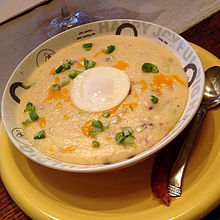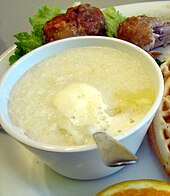This is an old revision of this page, as edited by Mahagaja (talk | contribs) at 10:25, 18 January 2016 (Reverted edits by 124.191.165.234 (talk) to last version by Bender235). The present address (URL) is a permanent link to this revision, which may differ significantly from the current revision.
Revision as of 10:25, 18 January 2016 by Mahagaja (talk | contribs) (Reverted edits by 124.191.165.234 (talk) to last version by Bender235)(diff) ← Previous revision | Latest revision (diff) | Newer revision → (diff) For the Canadian Political party colloquially known as the Grits, see Clear Grits. Grits, as a breakfast side-dish with bacon, scrambled eggs and toast Grits, as a breakfast side-dish with bacon, scrambled eggs and toast | |
| Type | Porridge |
|---|---|
| Main ingredients | Ground Corn |
| Variations | Hominy grits Yellow speckled grits |
| Other information | Soul food |

Grits is a food made by boiling ground maize (also known as corn), and usually served with other flavorings as a breakfast dish, usually savory. It is popular in the Southern United States.
Grits is of Native American origin, and is similar to other thick maize-based porridges from around the world such as polenta.
Modern grits are commonly made of alkali-treated corn known as hominy, in which case it may be called "hominy grits". "Instant grits" and "quick grits" use hominy processed for faster cooking, widely sold in supermarkets.
The word "grits" may be treated as either singular or plural; historically, in the American South it was always singular. It derives from the Old English word "grytt," meaning coarse meal.
Origins
Grits have their origin in Native American corn preparation. Traditionally, the hominy for grits was ground on a stone mill. The ground hominy is then passed through screens, the finer sifted material used as grit meal, and the coarser as grits. Many American communities used a gristmill until the mid-twentieth century, farmers bringing their corn to be ground, and the miller keeping a portion as his fee. State law in South Carolina requires grits and corn meal to be enriched, similar to the requirement for flour, unless the grits are made from the corn a miller kept as his fee.
Three-quarters of grits sold in the U.S. are bought in the South, in an area stretching from Texas to Virginia that is sometimes called the "grits belt". The state of Georgia declared grits its official prepared food in 2002. Similar bills have been introduced in South Carolina, with one declaring:
Whereas, throughout its history, the South has relished its grits, making them a symbol of its diet, its customs, its humor, and its hospitality, and whereas, every community in the State of South Carolina used to be the site of a grits mill and every local economy in the State used to be dependent on its product; and whereas, grits has been a part of the life of every South Carolinian of whatever race, background, gender, and income; and whereas, grits could very well play a vital role in the future of not only this State, but also the world, if as Charleston's The Post and Courier proclaimed in 1952, "An inexpensive, simple, and thoroughly digestible food, should be made popular throughout the world. Given enough of it, the inhabitants of planet Earth would have nothing to fight about. A man full of is a man of peace."
In the South Carolina Lowcountry, the uncooked ground corn is known as "grist", and the cooked dish is "hominy". This is distinct from the usual use of the term hominy.
Grits are either yellow or white, depending on the color of corn. The most common version in supermarkets is "quick" grits, which have the germ and hull removed. Whole kernel grits are sometimes called "Speckled".
Preparation

Whole kernel grits are prepared by adding five or six parts boiling water (seasoned with salt - 1/4 tsp for each cup of water) to one part grits and cooking for 20 to 45 minutes. Grits expand when cooked and need periodic stirring to prevent sticking, and lumps from forming. They are not done until they have absorbed four times their volume of water. The additional water allows for some evaporation as they cook. Whole grain grits require much longer to become soft than do "quick grits." Grits are most typically served seasoned with salt and pepper, as well as generous amounts of butter. On occasion they are served with grated cheese, sausage, bacon, or red-eye gravy. Grits may also be seasoned with butter and sugar, and a small amount of salt, giving them a salty-sweet flavor similar to kettle corn.
Extra, i.e. left-over, grits can be put into a glass tumbler, chilled until needed, sliced into slabs with a taut string, and fried, either plain or with a breading. In this form they are denominated "fried grits" ("fried hominy" in the Lowcountry).
Grits dishes
Grits are eaten with a wide variety of foods, such as eggs and bacon, fried catfish, salmon croquettes, country ham, and many other dishes.
Shrimp and grits is a traditional dish in the Low Country of coastal Alabama, Mississippi, Florida, Louisiana, South Carolina, North Carolina, Georgia, Virginia, and Maryland. A variation of the dish also is consumed for breakfast in the northern states of Kedah and Perlis in peninsular Malaysia. It is a traditional breakfast dish.
"Charleston-style grits" are boiled in milk instead of water, giving them a creamy consistency.
Solidified cooked grits can be sliced and fried directly in vegetable oil, butter, or bacon grease, or they can first be breaded in beaten egg and bread crumbs.
See also
- Cuisine of the Southern United States
- Cuisine of the United States
- List of porridges
- Mush (cornmeal)
- Hasty pudding
- Three Sisters (agriculture)
References
- Harper, Douglas, Online Etymology Dictionary: grits, retrieved August 27, 2011
- South Carolina Code of Laws, Title 39 – Trade and Commerce, Chapter 29, retrieved Dec 14, 2007
- Charles L., Cutler (2002). Tracks that speak: the legacy of Native American words in North American culture. USA: Houghton Mifflin. p. 28. ISBN 0-618-06510-5., retrieved Oct 25, 2009
- Georgia Secretary of State, State Prepared Food, retrieved Dec 14, 2007
- South Carolina General Assembly 113th Session, 1999–2000, Bill Number: 4806, retrieved Dec 14, 2007
| Maize and corn | |||||||||||||||
|---|---|---|---|---|---|---|---|---|---|---|---|---|---|---|---|
| Varieties | |||||||||||||||
| Parts | |||||||||||||||
| Processing | |||||||||||||||
| Pathology | |||||||||||||||
| Production | |||||||||||||||
| Culture |
| ||||||||||||||
| Maize dishes |
| ||||||||||||||